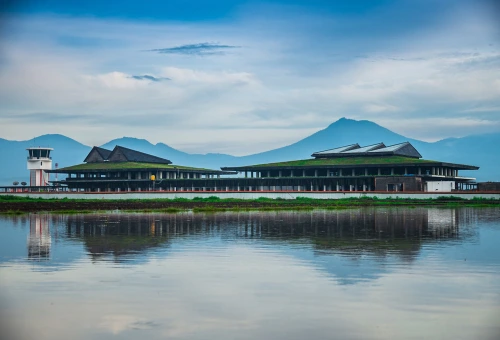
Far from being economically idle and disconnected from regional and national economic flows, intermediary cities in Asia and their hinterlands are increasingly being seen as dynamic, productive landscapes.

It is estimated that the goods and services that intermediary cities generate contribute to nearly 40% of the gross domestic product (GDP).
Diverse economic base
It is important to consider that goods and services from Asian intermediary cities have a global impact as they cross national borders and are intrinsically connected to the workings of the global economy.
Recent studies on global value chains (GCV) have shown the non-negligible contribution of goods produced in intermediary cities across Asia in terms of the wide range of products that are marketed and sold worldwide. While the participation rate of Asian countries in the GCV varies considerably, studies on the geographic distribution of goods contributing to the GCV reveal hotspots in and around Asian intermediary cities.
The emerging economic roles of intermediary cities place even more importance on integrating them into a robust and diverse economic base through careful planning. To achieve this, national and sub-national governments must have access to detailed spatial data on economic distribution in and across these cities.
However, compiling and collecting such data can be challenging, especially considering the prevalence of micro to small-sized enterprises in Asian economies and the notion of ‘hidden urbanism’ that characterises smaller intermediary Asian cities. Nonetheless, advances in computational and spatial techniques offer scalable and standardised methods for developing high-resolution data on economic activities embedded in space, complementing observational and field survey data such as Indonesia’s 2016 Economic Census.
To gain a more comprehensive understanding of the economic base in Asian intermediary cities, it is crucial to have robust databases that provide detailed information on economic activities. Such databases can shed light on spatiotemporal economic distribution, the degree of specialisation, locational factors associated with enterprise clustering, and more.
These databases can provide a more comprehensive picture of the economic landscape in Asian intermediary cities.
Underpinning the importance of a diverse economic base and the need to amplify economic activities in and across Asian intermediary cities is the notion that the current primate city development pattern, as is evidenced in South East Asia’s largest conurbations – from Jakarta, Indonesia, to Bangkok, Thailand, to Manila in the Philippines – may inhibit economic growth. Indeed, such overreliance on primate cities pattern is associated with greater regional disparities, subduing national productivity, and lower GDP.
Vision, leadership and sound governance
Given the important roles that Asian intermediary cities play, visionary and sound governance is essential to address their multi-faceted challenges. This will enable these cities to become more sustainable, resilient, livable and attractive.
In the past decade, there have been notable local government-driven innovations that have put a spotlight on intermediary cities across Asia.
Banyuwangi, the easternmost intermediary city in East Java, Indonesia, for example, has implemented a series of innovative civic architecture works aimed at rejuvenating the city and improving livelihoods. One of these works, the Banyuwangi Airport, recently won the 2022 Aga Khan Award for Architecture.
Innovative governance has emerged not only in the larger and more established cities but also in intermediary cities, despite historically being perceived as having lower levels of governing and technical capacities.
While it is true that intermediary cities may have lower levels of technical capacities compared with their metropolis and national government counterparts, particularly as measured using coarse indicators such as the educational attainment of the workforce, this may not necessarily apply to all cities. Positive outliers of inspired leadership can elevate intermediary cities, largely driven by elected officials and non-elite mayors.
A great example of this is how the then-mayor of Solo, Joko Widodo, amplified the role of city government in shaping national policy. The key policy-relevant question is how to nurture and sustain inspired leadership while simultaneously amplifying the governing and technical capacities of the local workforce.
While there are cases of inspired leadership in Asian intermediary cities, this should become the norm rather than an exception. Coalitions between local and national governments, regional associations, and the international community could facilitate nurturing such inspired leadership.
A conclusion on intermediary cities
Planning for sustainable urbanisation is a global challenge in which specific regions and types of settlement play unique roles. Focusing on intermediary cities in Asia is especially important in this regard for several primary reasons:
- It is precisely where urbanisation is most intensive and rapid, and where its impacts are likely to be most severely felt by the largest number of people.
- Intermediary cities have important environmental roles as they usually serve as the interface between exceptionally large concentrations of people in megacities, surrounding productive landscapes, bioregions, and precious wilderness areas.
- Intermediary cities in Asia, like all intermediate cities, rarely catch the media limelight. But in Asia, such cities are also systematically underrepresented in research and policy studies.
- Relevant planning policy is often weakest in these areas, with data often uneven in quality and capacity to contribute to and implement plans limited.
These factors are not uniformly debilitating. There is plenty of evidence of innovation, experimentation, and vision in intermediary cities around matters as diverse as waste management, cultural industries, effective governance, the local economy, and environmental protection.
However, nuanced and scale-sensitive support is needed so that these efforts flourish and contribute to credible pathways for sustainable development.
This article by Stephen Cairns, professor urban design, Alex Lechner, professor urban design, Alyas Widita, assistant professor urban design, Diego Ramírez-Lovering, professor of architecture of the Faculty of Art Design and Architecture, and Eka Permanasari, associate professor urban design, architecture and South East Asian studies, all of Monash University, Indonesia, is part of a series on intermediary cities in Asia.
The previous parts focused on Autonomy and integration and Citizen and community well-being, and Equitable and sustainable design and Experimentation and innovation.






